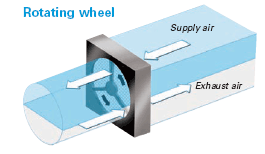Rotating wheel technology is sometimes referred to as rotary heat exchange. Rotating wheels are typically constructed of aluminum, copper, stainless steel or monel and include a dedicated electric motor and drive belt(s). The wheel can be purchased as a stand alone cassette, with fans, or as an assembly complete with a filtration system and other needed components.

How it works
With this technology, a wheel rotates, absorbing and transferring energy from an exhaust air
stream to an intake air stream. Either warm air is cooled, or cool air is warmed, depending on the need. The air streams can be directed in either parallel or counter flow patterns, whichever is most convenient.
Wheels are among the most effective of energy recovery systems, operating at 50 to 85 percent efficiency, depending on application type. However, they require a good filtration system to optimize energy transfer.
Generally, the size and depth of the wheel, along with its speed, will determine the rate of recovery. Additional controls could include wheel speed controls and/or face and bypass dampers. There are two types of rotating wheels, sensible heat wheels and total energy wheels.
Sensible wheels, also called
heat wheels, transfer sensible heat, or heat which can be felt and measured on a thermometer. Humidity is not transferred. Sensible wheels are often used in office buildings and other facilities where humidity is not a critical factor.
Energy wheels, also known as
total energy wheels and
enthalpy wheels, use the application of a desiccant (or absorbent) material such as molecular sieve or silica gel for humidity transfer. A portion of the moisture in the air stream with a higher humidity ratio will transfer to an area of lower humidity.
To determine the best system for a facility, the ideal amount of humidity to be recovered should be included in the air properties calculation. This wheel type can be a good choice for schools, hospitals and other environments where maintaining comfortable humidity is important.
Caution: With rotating wheel systems, there is typically some leakage between the intake and exhaust air streams. In most HVAC applications, the mix of ventilation air can be 5 to 30 percent of the air supplied to the space. That means that 70 to 95 percent of the air supplied to the space is recycled. If the exhaust air is toxic or contains odors from a bathroom exhaust system and a small amount of carryover is not acceptable, then a wheel may not be the right energy recovery system for the facility.
A potential solution for contamination is to add a purge section into the wheel assembly. A purge uses a small amount of ventilation air to drive the exhaust air trapped in the wheel from the ventilation side of the wheel and back to the exhaust side of the wheel. The purge system may cause an increase in energy use to drive the fan but can effectively eliminate unhealthy exhaust air.